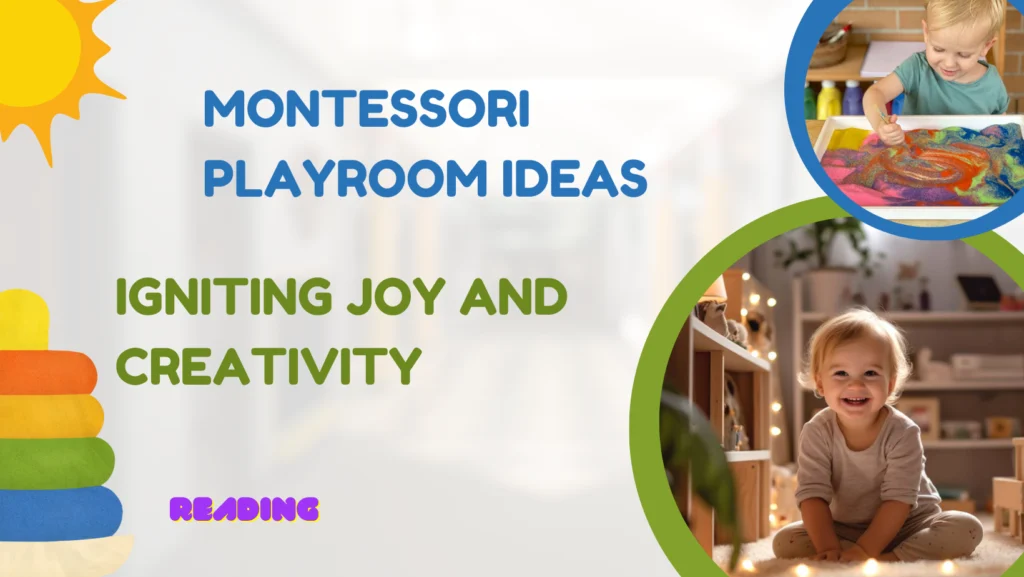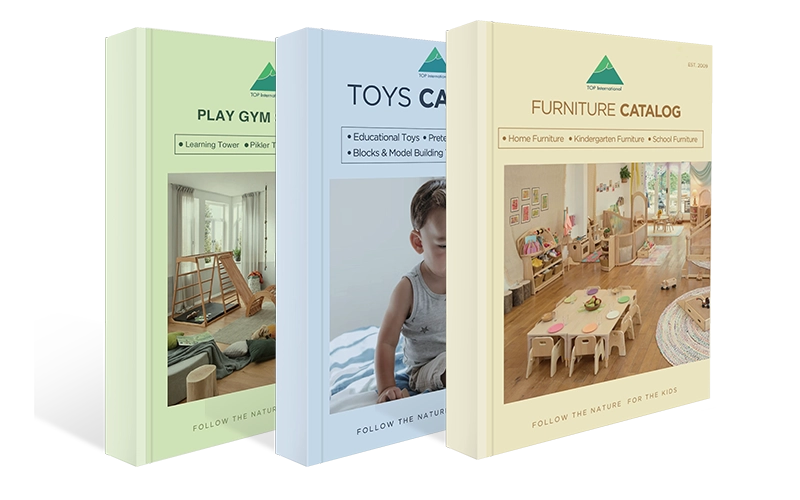Are you pondering how to infuse your kid’s play area with Montessori playroom ideas that ignite joy and creativity? Curious about how to meld aesthetics with educational functionality? Seeking inspiration for a Montessori playroom that fosters independence and a love for learning? How can you transform a simple room into a vibrant place of imagination and growth tailored to your child’s developmental needs?
We aim to sculpt an ambiance where Montessori playroom ideas come to life, harmonizing educational values with the joy of play. These ideas revolve around creating a purposeful space that invites curiosity and self-initiated learning. By integrating child-friendly furniture, thoughtfully selected Montessori materials, and a layout that supports easy access and independence, we construct environments that empower children to engage deeply and confidently with their surroundings.
As we delve deeper into the nuances of Montessori playroom ideas, we uncover the significance of designing areas that are not just visually appealing but also intellectually stimulating. From choosing versatile toys that spur creative problem-solving to establishing areas dedicated to arts, crafts, and nature exploration, these playroom concepts are meticulously crafted to enhance cognitive development and sensory exploration, making children thrive in a world of discovery and joy.
Understanding the Montessori Method
Understanding the Montessori Method involves delving into a philosophy that prioritizes kid-centered learning. At its core, this method empowers kids to take the lead in their own education, emphasizing self-directed activity, hands-on learning, and collaborative play. The Montessori approach is holistic, aiming to develop the whole kid, including their physical, social, emotional, and cognitive growth. Therefore, when applying Montessori principles to playroom design, the goal is to create an environment that is orderly, aesthetically pleasing, and aligned with the kid’s intrinsic learning tendencies. This space should be equipped with materials and activities designed to stimulate curiosity and encourage the development of essential skills such as critical thinking, problem-solving, and independence.

The Importance of the Montessori Playroom Ideas
In the Montessori playroom, every detail is meticulously planned to support holistic kid development. These spaces are crafted to encourage learning through play, blending educational principles with imaginative exploration.
- Fostering Cognitive Growth: Montessori playroom ideas are integral in nurturing a kid’s cognitive development. Kids are encouraged to engage in problem-solving, critical thinking, and decision-making through carefully selected activities and materials. This intentional design allows kids to experience learning at their own pace, promoting a more profound understanding and retention of knowledge.
- Building Independence and Confidence: A Montessori playroom fosters emotional well-being by allowing kids to make choices and take responsibility for their learning. This autonomy builds self-esteem and confidence as kids learn to trust their abilities and judgment. The environment is structured to provide a sense of security and belonging, where children feel valued and understood.
- Encouraging Motor Skills and Coordination: The design of a Montessori playroom emphasizes the importance of physical activity and development. With kid-sized furniture and accessible resources, kids are encouraged to move freely, enhancing their motor skills and coordination. Activities promote gross and fine motor development, from climbing and balancing to sorting and threading.
- Encouraging Exploration and Discovery: Montessori playroom ideas aim to ignite creativity and imagination, offering a wealth of resources for exploration and discovery. Open-ended materials and creative play spaces inspire kids to invent, create, and imagine, fostering a love for learning. This exploratory approach allows kids to express themselves and interpret the world around them through their unique perspectives.
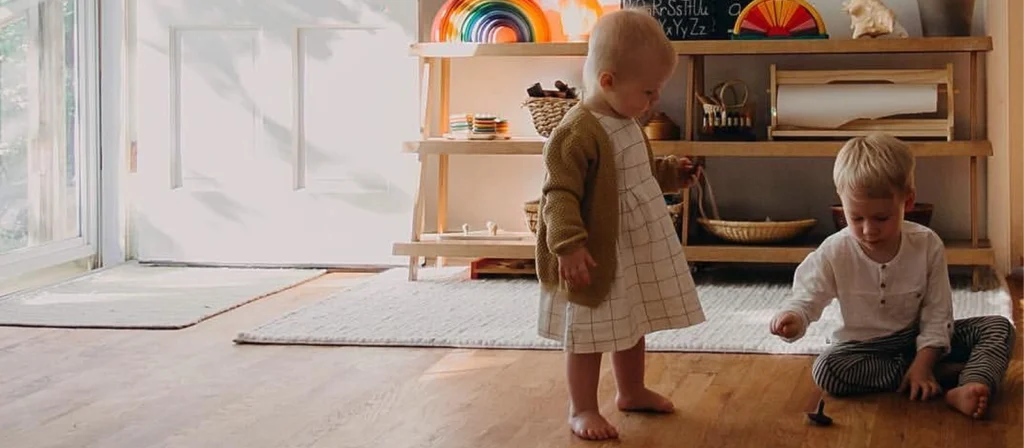
Montessori Playroom Ideas Design and Aesthetics
The design and aesthetics of a Montessori playroom are crucial in shaping an environment conducive to learning and growth. This approach emphasizes simplicity, natural beauty, and functionality, creating calming and inspiring spaces. In a Montessori playroom, the arrangement is intentional, with materials and furniture selected for their educational value and ability to foster independence. Neutral colors, natural light, and uncluttered spaces are hallmarks of Montessori aesthetics, providing a serene backdrop that enhances concentration and mindfulness.

Layout of a Montessori Playroom Ideas
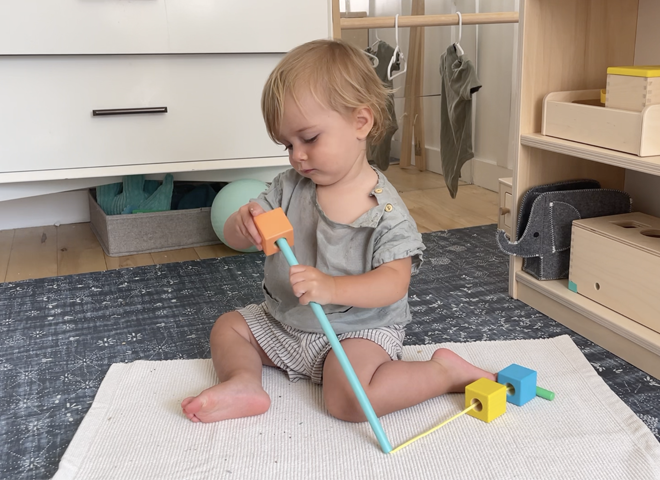
Defining Activity Zones
In a Montessori playroom, the layout is segmented into distinct activity zones, each designed to support different areas of learning and development. These zones might include areas for practical life skills, sensory play, creative arts, reading, and more. By having these separate yet accessible areas, children can choose activities based on their interests, leading to more engaged and meaningful play.
Enhancing Independence
The layout is carefully planned to ensure that all materials and furniture are easily accessible to the children, promoting their independence and self-sufficiency. Shelves are placed at the kid’s height, and materials are organized orderly, allowing kids to take and return items independently. This setup fosters a sense of autonomy and responsibility in the kid.
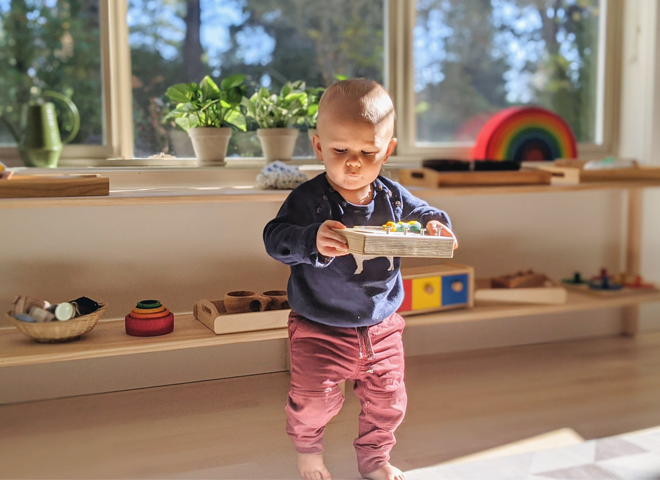
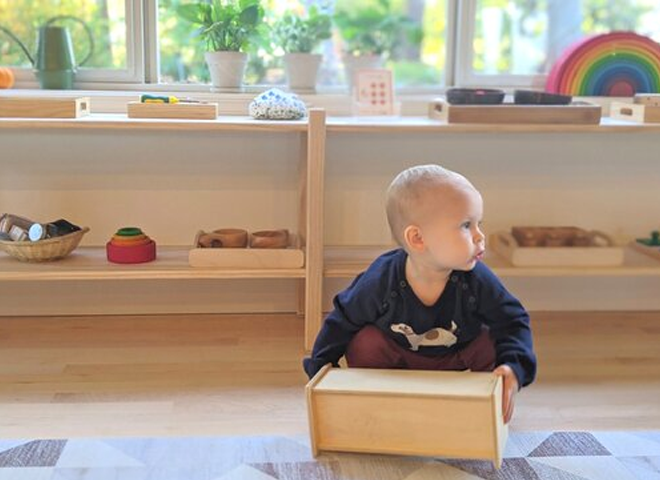
Encouraging Movement and Exploration
The Montessori playroom ideas encourage free movement and exploration, which is crucial for the kid’s physical development and cognitive growth. Ample space allows kids to move freely, facilitating a natural flow of activity and exploration within the room. This open layout helps kids make connections between different activities and concepts, enhancing their overall learning experience.
Supporting Concentration and Focus
The playroom’s layout minimizes distractions and creates a peaceful environment conducive to deep concentration and focus. Each activity zone is designed to be inviting and engaging, with materials presented in an orderly manner that attracts the kid’s attention and encourages extended periods of focused play and learning.

Using the natural materials
Incorporating natural materials into a Montessori playroom is essential for creating an aesthetically pleasing and beneficial environment for children’s development. These materials, such as wood, wool, cotton, and stone, offer tactile and sensory experiences that synthetic materials cannot match. They connect children with the natural world, fostering a sense of wonder and respect for their environment. Additionally, natural materials are often more durable and safe, providing a sustainable and healthy option for play and learning spaces.
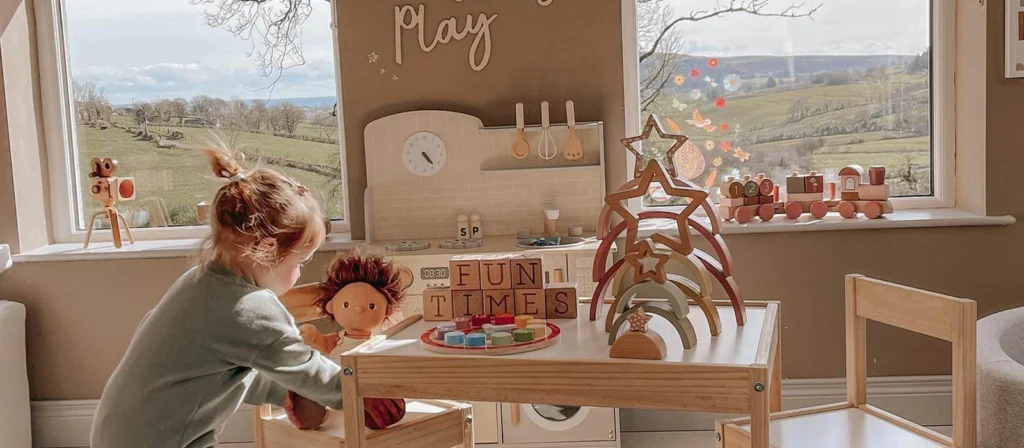
Choosing Montessori-approved Toys
Choosing Montessori-approved toys means selecting items that nurture the child’s development in beneficial ways.
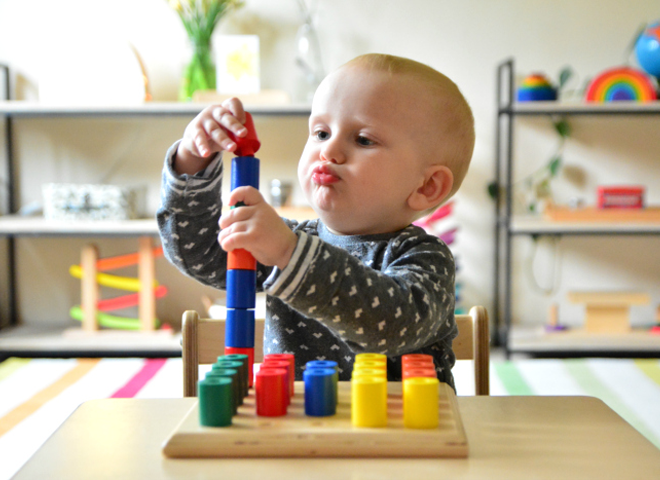
Sensorial Exploration Toys
Toys like color gradation blocks, sound boxes, and texture boards help kid refine their sensory skills and awareness. These materials isolate one sense at a time, enhancing the kid’s observation and discrimination abilities.
Practical Life Skills Toys
Items such as dressing frames, pouring and spooning activities, and cleaning tools are used to develop fine motor skills and teach daily life activities. They encourage kids to independently practice self-care and household tasks, building their confidence and autonomy.
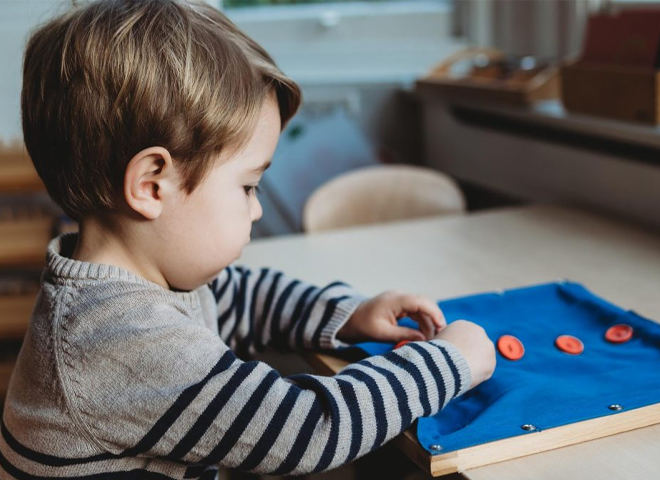
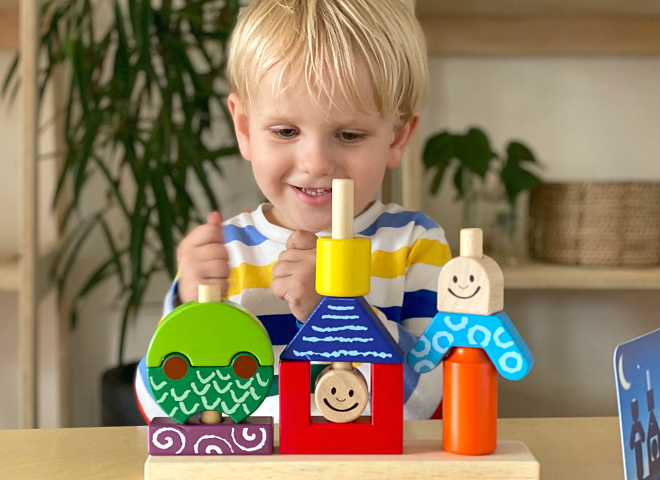
Cognitive Development Toys
Puzzles, sorting and sequencing games, and counting materials fall into this category. They are essential for teaching problem-solving, logical thinking, and mathematical concepts, providing a foundation for academic skills.
Creative and Imaginative Play Toys
Dolls play kitchens, and art supplies like crayons and clay support imaginative play and creativity. These toys allow kids to express themselves, tell stories, and experiment with different mediums, fostering their artistic talents and narrative skills.
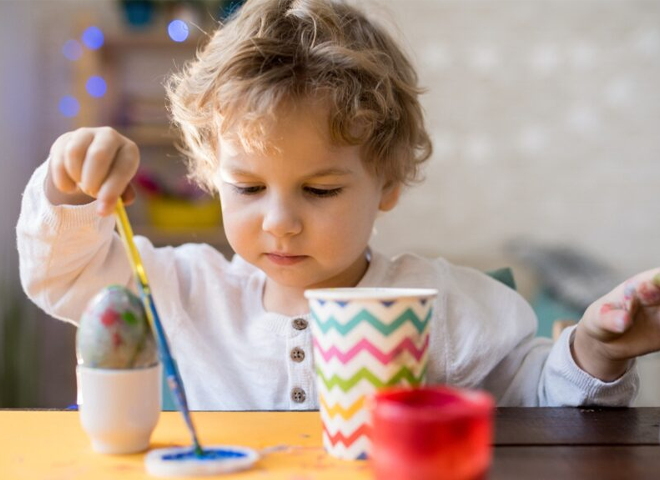
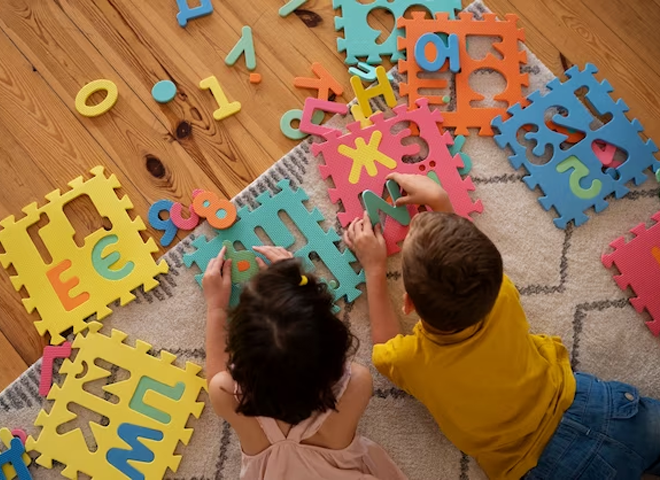
Language and Literacy Toys
Alphabet blocks, phonetic reading materials, and simple word puzzles promote language acquisition and literacy skills. These toys help kids recognize letters, build vocabulary, and develop early reading and writing abilities.
Montessori Playroom Ideas Furniture
- Kid-Sized Furniture: In the Montessori playroom ideas, furniture is scaled to kid-size to promote independence and ease of use. Tables, chairs, and shelves should be at the right height for kids to access comfortably, enabling them to sit, work, and retrieve materials without adult assistance. This autonomy in the physical environment reinforces the kid’s ability to act independently and make choices.
- Safe and Natural Materials: Montessori playroom furniture is often made from natural materials like wood, which is durable, non-toxic, and aesthetically pleasing. Using natural materials connects children with the natural world, supports sensory development, and ensures a safe play environment free from harmful chemicals often found in synthetic furnishings.
- Aesthetic and Functional Design: The aesthetic of Montessori playroom ideas furniture should be simple and functional, avoiding overly bright colors or complex patterns that could distract from the learning process. The design should complement the Montessori ethos of clarity and order, with open shelves for easy access to materials and cozy, defined areas for concentrated activities. The aim is to create a harmonious, inviting space that stimulates learning and growth.
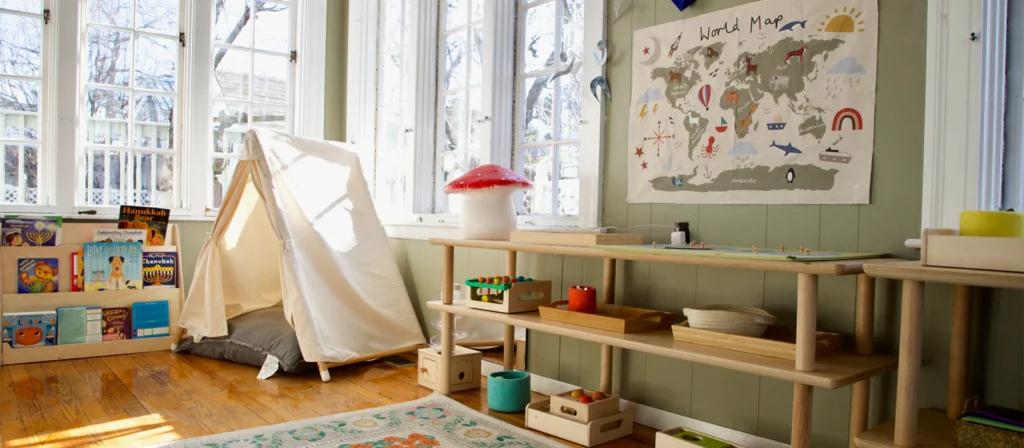
Storing Montessori Items
In a Montessori playroom, items are stored to promote independence, order, and accessibility. Furniture like open shelves and low cabinets allows children to see, reach easily, and return materials, fostering self-reliance and organizational skills. These storage solutions are neatly categorized to help children understand and maintain the organization of their learning environment. Emphasizing simplicity and coherence with the playroom’s design, the storage system integrates natural materials and soft colors, maintaining the calm and inviting atmosphere central to Montessori principles. This thoughtful approach to storing Montessori items not only keeps the playroom tidy but also supports the educational goals of the Montessori method.
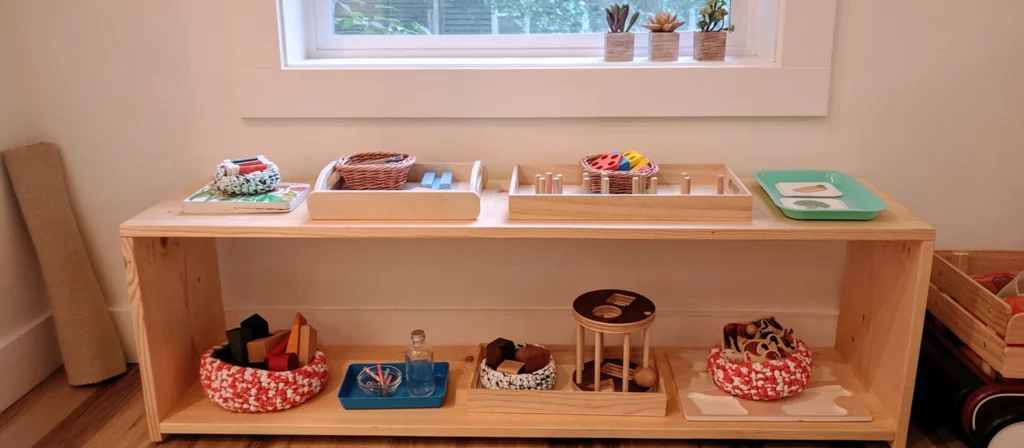
Activity Areas for Different Age
In a Montessori playroom, activity areas are thoughtfully designed to cater to the evolving needs of different age groups, ensuring that each child’s developmental stage is supported with appropriate materials and challenges.
| Age Range | Activity Focus | Suggested Materials |
| 0-6 months | Visual and auditory sensory development | High-contrast visuals, soft mats, safe mirrors, gentle sound objects |
| 6-12 months | Fine motor skills and sensory exploration | Shape sorters, soft blocks, textured balls, crawling tunnels |
| 1-2 years | Mobility and coordination | Push and pull toys, basic puzzles, household items for imaginative play |
| 2-3 years | Language skills and creative expression | Picture books, simple art materials, dressing frames, building sets |
Children’s Activities in Montessori Playrooms
- In Montessori playrooms, the activities provided are central to Montessori playroom ideas, carefully selected to enhance self-directed learning and comprehensive developmental growth. These engagements, stemming from practical Montessori playroom ideas, include pouring, scooping, and buttoning, pivotal in developing fine motor skills, hand-eye coordination, and daily living capabilities. Additionally, sensory activities aligned with Montessori playroom ideas, such as sorting by size, shape, or color and exploring different textures and sounds, are integral in sharpening cognitive skills and heightening sensory perception, allowing kids to understand their environment better.
- The second part of the Montessori playroom experience, deeply rooted in Montessori playroom ideas, emphasizes the importance of hands-on, interactive learning. These activities, reflective of Montessori playroom ideas, are designed to cultivate independence, critical thinking, and creative problem-solving. kids are encouraged to explore and manipulate materials, leading to meaningful discoveries and insights. This approach, a hallmark of Montessori playroom ideas, ensures that the tasks are educational and engaging, keeping the child’s interest alive. By aligning these activities with the individual developmental stages of each kid, Montessori playrooms provide a rich environment that fosters a robust love for learning, curiosity, and self-discovery, setting a solid foundation for future educational success.

Conclusion: Creating a Joyful Space for Your Children
In conclusion, designing a Montessori playroom with Montessori playroom ideas is about crafting a space where joy and learning intersect seamlessly for your kids. Integrating Montessori principles and these playroom ideas creates an environment that nurtures curiosity, fosters development, and encourages a lifelong passion for exploration and knowledge. This joyful space becomes a haven where your kids can thrive, discover, and grow harmoniously with their natural inclinations and abilities.

